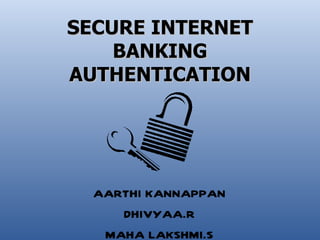
wed
- 1. SECURE INTERNET BANKING AUTHENTICATION AARTHI KANNAPPAN DHIVYAA.R MAHA LAKSHMI.S
- 2. Network Security c tion Offline cr trod u edential In Attacks on Onl Sho ine authentication rt t cha ime pwd nn el Abstract nomy bjec tives k t axo o At tac Conclusion sol ution based f icate Certi 2
- 3. PRESENTATION OBJECTIVES Understand network security services Be aware of vulnerabilities and threats Realize why network security is necessary Highly attractive solution for valuable and secure future. 3
- 4. ABSTRACT The authors present two challenge response Internet banking authentication solutions one based on short-time passwords and one on certificates attacks on authentication transaction-signing option 4
- 5. INTRODUCTION The Internet is an integral part of our daily lives, and the proportion of people who expect to be able to manage their bank accounts anywhere, anytime is constantly growing This article describes current Authentication threats and two proposed solutions as well as how these solutions can be extended in the face of more complex future attacks 5
- 6. ATTACKS ON AUTHENTICATION Internet banking systems must authenticate users before granting them access to particular services. successful authentication eventually enables users to access their private information. We can classify all Internet banking authentication methods according to their resistance to two types of common attacks offline credential-stealing attacks online channel-breaking attacks 6
- 7. Offline credential-stealing attacks Security precautions can help users protect themselves from malicious software. For example-- installing and maintaining a firewall and up-to date antivirus software, regularly applying operating system and browser patches 7
- 8. Online channel-breaking attack The intruder noticeably intercepts messages between the client PC and the banking server by masquerading as the server to the client and vice versa Online channel-breaking attacks don’t necessarily compromise the user’s credentials but the session’s credentials and therefore typically require the user-initiated banking 8 session to work properly.
- 9. AN ATTACK TAXONOMY Taxonomy of Internet banking authentication methods. Methods are classified according to their resistance against offline 9 credential-stealing and online channel-breaking attacks.
- 10. SHORT-TIME PASSWORD SOLUTION It uses symmetric cryptography in combination with a hardware security module . User authentication works as follows: 4. The user connects to the Internet banking 5. The user claims his or her identity by entering an account number in the bank’s login form 6. The user opens his or her smart card by entering the corresponding PIN in the reader before entering the given challenge. 7. The user manually copies the shown response to the bank’s login form to be checked by the bank’s authentication server. 10
- 11. The Need for Web Security 11
- 12. CERTIFICATE-BASED SOLUTION User authentication works as follows. First, the user establishes an SSL/TLS channel between the user PC and the bank’s Web server by setting up an SSL/TLS session without client authentication. Once the card is available, its certificates become visible in the Web browser. 12
- 13. Conclusion Internet banking has turned into an arms race between financial institutions and public network attackers. Both solutions offer high security against common attacks. However, changing legislation and the eventually spread of e-IDs among customers makes this solution a highly attractive and valuable alternative for the future. 13
- 14. THANK YOU Network security!!!!!!!! 14
Editor's Notes
- This sub-section addresses why Internet security is a problem and how it came to be that we are depending on an infrastructure with fundamental vulnerabilities. updated 2000-08-07
- Confidentiality Integrity Authentication Ensures that the origin of a message is correctly identified, with an assurance that the identity is not false Nonrepudiation Neither the sender nor the receiver of a message is able to deny the transmission Access Control Availability